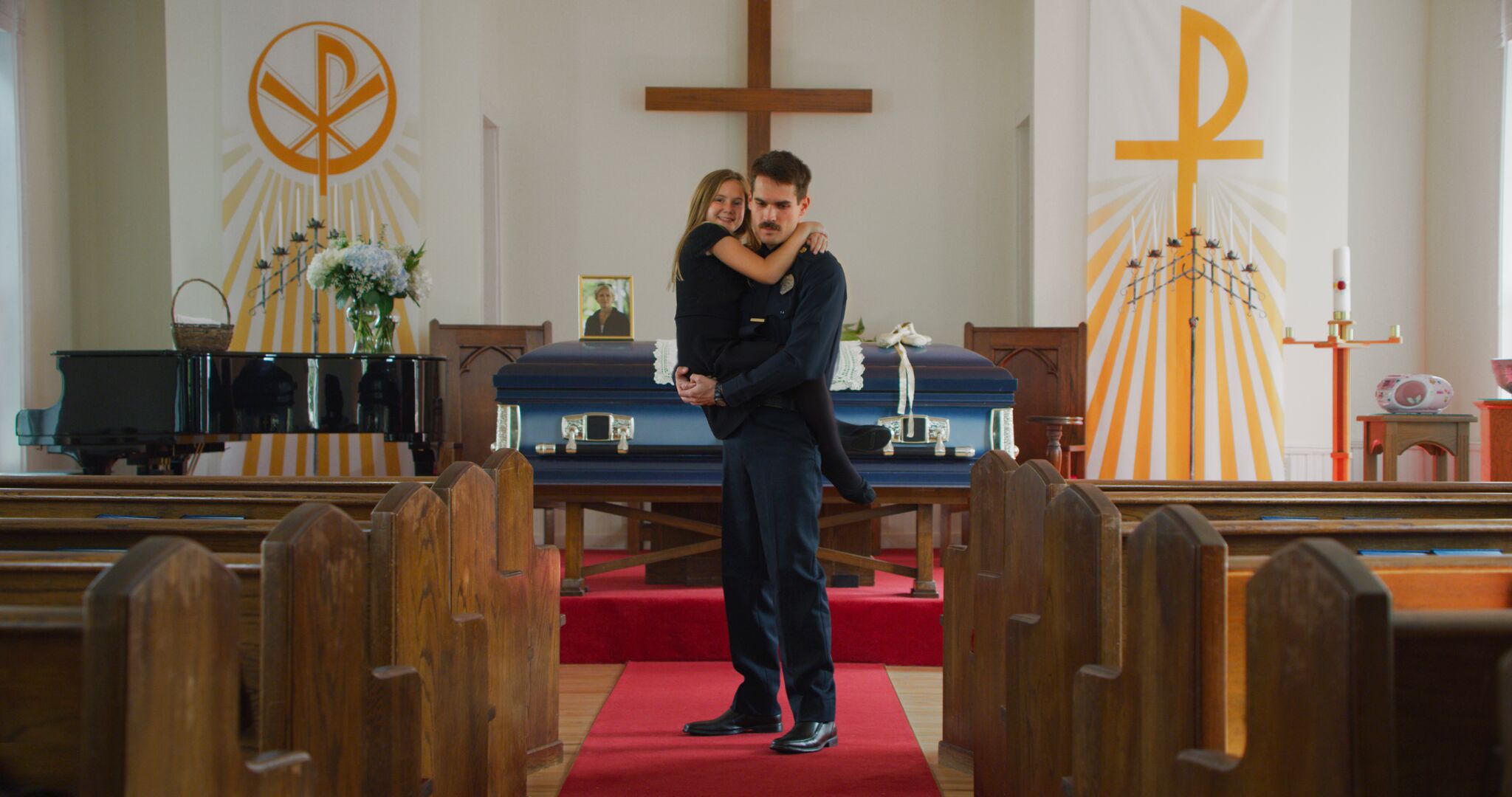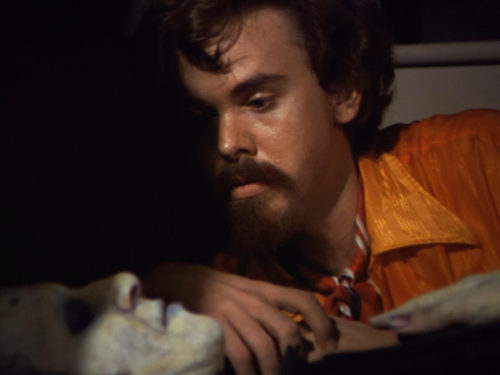Building from a 2016 short film of the same title, Cummings’ first feature film tackles the difficulty of expressing emotions in our most difficult moments
Jim Cummings works best in snapshots. He has made a name for himself in a series of short films, most shot in a single take, that blur the line between comedy and drama to a point where the broadness of such labels becomes meaningless. His short films throw us into situations where moments of extreme human emotion are met by a rush of increasingly complicated social circumstances. Whether it’s the flamboyant and terminally-ill YouTube celebrity of The Mountains of Mourne (2017) or the crack-smoking would-be liquor store bandit in The Robbery (2017), Cummings has a way of bringing his often extravagant figures down to Earth. He lets them writhe around in a delicately structured dance between attempts at sincere expression and the personal insecurities and overbearing conventions that rule over their identities.
There is a great feature filmmaker developing in Thunder Road, Cummings’ first feature. The challenge ahead for the young director lies in recognizing and developing his own strengths.
Thunder Road is based on Cummings’ 2016 short of the same title. The short holds us in a baffling place as we watch a mourning son — a police officer named Jim, played by Cummings — perform a dance routine to Bruce Springsteen’s “Thunder Road” as a tribute during his mother’s funeral. In theory, Jim comes from the sincerest of places; it was his mother’s favorite song, and she was a dancer. In practice, the 12-minute short, shot in a single long take, is a painful public display of emotional inarticulateness and spiritual uncertainty. The short excels by keeping us disoriented. Jim may look like a caricatured movie cop, but the conventionalism lies in appearance only. The lack of background we have on this nervous man in uniform sustains a distance that denies our ability to write him off as a joke. He fumbles through his eulogy with incomplete tangents; he interrupts himself when his rambling stories get too personal; he apologizes to faceless individuals in the pews. We may want to laugh, even if only to keep from crying. But by the time a chuckle is about to surface, Cummings’ performance has stumble-danced into new emotional territory. The short shows us how ugly and embarrassing a genuine stream of emotion can be, particularly when trying to articulate the confusion and pain we so often fight back and avoid facing.
The feature begins with a reenactment of the short, this time without Springsteen’s title song to “guide” Jim. While the short benefits from having the song play, if only to add to the overall noise of the atmosphere, its absence creates a new set of complications. With a busted CD player, Jim is left to talk the crowd through the song as he dances. “There’s a harmonica here,” he says as he flutters his fingers in the air. In a film rooted in performance, the absence of the song allows Cummings to further layer his delivery, as his character internalizes the music and brings it out through hesitant gestures.
Thunder Road would certainly make for a strong double feature with another directorial debut rooted in Springsteen’s music, Sean Penn’s The Indian Runner (1991), as it too concerns a policeman whose job interferes with a troubled family life. But where Indian Runner faces its sergeant with a disturbed brother, Jim’s worst enemy is himself. The feature further develops the pressures and conflicts surrounding Jim’s life involving the stress of his job, his divorce and custody battle over his daughter, Crystal (Kendal Farr), while complicating (yet wisely never resolving) Jim’s relationship with his mother.
But beyond the bumper sticker social statements that many will apply to the protagonist being a police officer, it is the personal elements and the internal conflicts relating to the policeman’s uniform that make Thunder Road such a provocative work. With any uniform or profession, there is a suppression of feeling and emotion required while on the job. Cummings sets Jim’s personal suffering and lack of control over his expression against the high stakes and strictness of uniformity that comes with being a police officer. Any time we see the gun hanging from Jim’s belt, we can’t help but worry, but we also can’t help but feel for him with the incredible emotional strain he is under. By placing such an unstable figure in a position where he is supposed to act with stoicism and steady judgement, the film works to understand how strenuous such repressions can be upon our emotional nature, particularly someone as vulnerable as Jim. The film tangles these elements to a point where we cannot sit back and judge Jim in a clear-cut fashion.
Cummings drives a great deal of the drama through his dialogue, which is riddled with hesitations, tangents, hasty outbursts and hastier apologies. Conflicts arise from misplaced tones and improperly stressed syllables. Some of the biggest confrontations come about when characters try to retract or apologize for their clumsy sentiments. Jim’s rambling leaves Crystal looking overwhelmed during her stay with him. He means well with his wall of talk, asking her if he can do just about anything for her, but when she wants to play a hand-clap game with him, he cannot hold focus and returns to his incessant babbling. When she later challenges him to give the game another shot, the gravity of her seriousness brings him to a focused silence, and he is able to dial in and interact with her in a direct way that his talk holds him from.

The characters in Cummings’ film are prone to distraction. Jim’s divorce lawyer doesn’t even know what case she is defending when she meets him outside the courtroom. The judge is more preoccupied with a half-consumed cup of juice left on his bench than in hearing Jim’s defense plea. But the film is at its best when it establishes a dramatic tension and suddenly jolts us into a new conflict through a character’s shifted attention. During his most trying moments Jim struggles to pay attention and often resembles a dog catching scent of a squirrel. During an intense talk with his daughter on her first day of school, Jim suddenly breaks concentration on his nervous little girl to honk his horn and wave offscreen to what we can only assume is a passing police car. Later, during a tense standoff with a suicidal chef wielding a knife, Jim and his partner Nate (Nican Robinson) comment on how attractive a young woman fleeing the scene is. By the time they dial back in to the task at hand and charge the kitchen, they find the man lying unconscious on the floor, creating a new set of problems. Cummings creates a great deal of freedom in his ability to steer the drama of his film with these pulls of his characters’ focus. By ripping them out of their moments, he is able to pluralize the conflicts in any given scene. In following the scatter-brained tangents and half-thoughts of his characters, Cummings opens his scenes and makes the most out of the suggestiveness that comes through their inarticulateness. We learn more from the bits and pieces than any film that tries to “round” out its characters through the simplifying clarity of epiphanies.
It is in these scenes that keep the emotions bound within an expressive limbo, where feelings of desire, frustration or regret are hinted but left hanging — or brought up but quickly smothered by the characters — where Thunder Road thrives. Cummings has mentioned that Springsteen’s music was a major influence on the film, and this is precisely where Springsteen’s best songs take place. Jim’s mother may have been inspired to leave her hometown to pursue a better life by “Thunder Road,” but the film itself resembles the broken dreams of Springsteen’s harsher material such as “Stolen Car” or “The Promise.” It’s easy to forget that the hope and opportunity of “Thunder Road” led Springsteen into the uncertainty of Darkness on the Edge of Town (1978) and the spiritual despair of Nebraska (1982). Springsteen’s music eventually found that one can take to the road to escape a job or a marriage gone sour, but that the inner turmoil, the things you can’t drive away from, are what can steer you toward oblivion. Is there a scarier question than, “Is a dream a lie if it don’t come true / Or is it something worse?”

Thunder Road is ultimately asking these types of unanswerable questions. One of the most striking scenes involves Jim visiting his sister (Chelsea Edmundson), who skipped their mother’s funeral. She mentions that she never felt close to her mother, but as soon as she is about to pass the threshold of facing her feelings, she shields herself with life’s clutter, of business meetings and having too much going on to address such an issue. She allows the distractions to take over. The film struggles in scenes that allow its characters to reach too high of a dramatic register where figures articulate a bit too much. Jim’s major breakdown in front of the police station and two heart-to-heart monologues, one given to a corpse, another to his daughter, move Thunder Road into routine drama that does a disservice to the more idiosyncratic aspects of Cummings’ style and structure. The film doesn’t need the scenes with cascades of tears and clothes being desperately stripped-off, or “full-circle” type moments where the importance of the film’s title is blatantly underscored. Hopefully Cummings will continue to develop his features within the constraints set by his shorts because no director since Andrew Bujalski in his first three films has been able to discover so much dramatic potential using the smallest, most hesitant turns of phrase and gesture, with such blistering emotional effect. Here’s hoping Cummings takes that road.
Follow Brett and Split Tooth Media on Twitter




